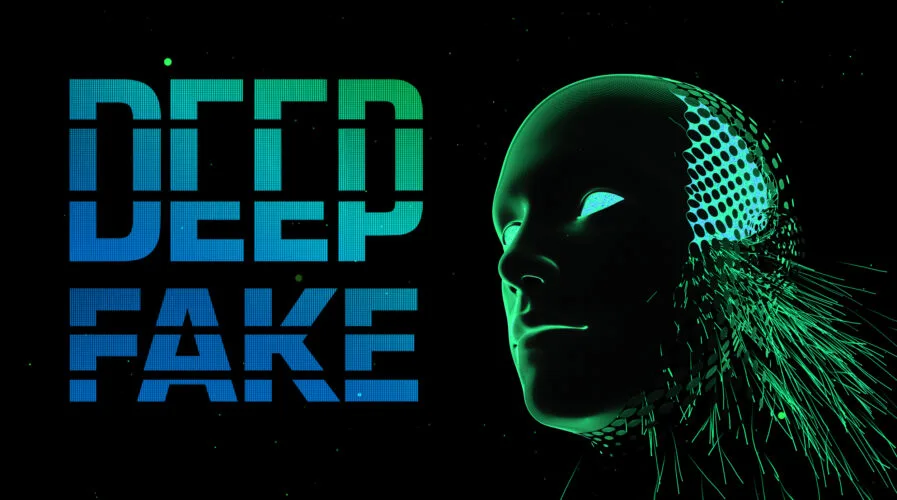In the ever-evolving landscape of cyber threats, two menacing forces have recently emerged as a double-edged sword, striking fear into the hearts of individuals and organizations alike: ransomware and deep fake technology. The convergence of these two malicious entities poses a new level of danger in the digital realm, blurring the lines between cybercrime and disinformation.
Deep fake

Deep fake is a technique that uses artificial intelligence to create highly realistic fake videos or audio recordings by superimposing existing images or recordings onto other content. Leveraging machine learning algorithms, deep fakes manipulate facial expressions, gestures, and voices, allowing for the creation of deceptive media that appears authentic. This technology poses risks by enabling the production of convincing misinformation, impersonation, or fraudulent content, raising concerns about its potential misuse in various domains, including disinformation campaigns, identity theft, and cyber threats. Countermeasures involve advancements in detection tools, increased awareness, and ongoing research to stay ahead of evolving deep fake techniques
Deepfake in Cybersecurity
In cybersecurity, deep fake technology poses a multifaceted threat, leveraging artificial intelligence to manipulate digital content and create deceptive media. Here are key aspects of deep fake’s role in cybersecurity:
- Social Engineering Attacks: Deep fakes can be used in sophisticated social engineering attacks. By impersonating trusted individuals, attackers may manipulate users into divulging sensitive information, clicking on malicious links, or compromising security.
- Disinformation Campaigns: Threat actors employ deep fakes to spread false information and manipulate public opinion. In cybersecurity contexts, this could involve creating deceptive content to mislead security teams, divert attention, or damage the reputation of individuals or organizations.
- Identity Theft: Deep fakes can facilitate identity theft by convincingly mimicking an individual’s appearance and voice. This raises concerns about unauthorized access to secure systems, especially when combined with other tactics to exploit compromised identities.
- Business Email Compromise (BEC): Deep fake audio or video can be used to impersonate executives or high-ranking individuals within an organization, enhancing the effectiveness of BEC attacks. This can lead to fraudulent financial transactions or unauthorized access to sensitive information.
- Credential Phishing: Deep fakes may enhance the effectiveness of phishing campaigns by creating convincing videos or voice messages that lure individuals into revealing login credentials or other sensitive information.
- Reputation Damage: In the cybersecurity landscape, deepfakes can tarnish the reputation of security professionals, companies, or even cybersecurity technologies. This could be part of a broader strategy to weaken trust in digital security measures.
- Misleading Incident Response: Deep fakes may be used to create fabricated incident response messages, misleading security teams during a cybersecurity incident. This could result in delayed or misguided responses, allowing attackers to further exploit vulnerabilities.
- Complex Attacks: Deep fake technology can be integrated into multi-vector cyber attacks, making them more sophisticated and challenging to detect. The convergence of deep fakes with other cyber threats amplifies the overall risk.
- Security Awareness and Training: Cybersecurity professionals need to stay informed about the evolving capabilities of this type of threats. Training programs should include awareness of potential deep fake threats and methods to mitigate risks.
- Detection and Mitigation: Advanced detection tools are essential for identifying deep fake content. Cybersecurity measures should focus on real-time monitoring, behavioral analysis, and other techniques to recognize manipulated media and mitigate associated risks.
Addressing the cybersecurity challenges posed by this technology requires a comprehensive approach, combining technological solutions, awareness training, and ongoing research to stay ahead of emerging threats. As deep fake technology evolves, the cybersecurity community must remain vigilant to protect against its potential misuse.
Ransomware

Ransomware is malicious software that encrypts a user’s files, rendering them inaccessible. Attackers demand a ransom, usually in cryptocurrency, in exchange for a decryption key. This cyber threat aims to coerce victims into paying to regain control over their data. Ransomware attacks often target individuals, businesses, or even critical infrastructure, causing disruptions, financial losses, and potential data breaches. Mitigation strategies include regular data backups, robust cybersecurity measures, and user education to prevent falling victim to phishing or malicious downloads. Cybersecurity professionals continually develop tools and strategies to detect, prevent, and respond to evolving ransomware threats.
why is Ransomware Dangerous?
Ransomware is particularly dangerous for several reasons:
- Data Encryption: Ransomware encrypts a victim’s files, making them inaccessible. This can have severe consequences for individuals, businesses, or critical infrastructure, disrupting operations and causing data loss.
- Financial Extortion: Attackers demand a ransom payment, usually in cryptocurrency, in exchange for a decryption key. This creates a direct financial incentive for victims to pay, perpetuating the cycle of ransomware attacks.
- Widespread Impact: Ransomware can spread rapidly across networks, affecting multiple systems and devices. This wide-reaching impact increases the potential for financial losses, service disruptions, and data breaches.
- Targeting Critical Infrastructure: Ransomware attacks often target critical infrastructure, including healthcare, energy, and government systems. Disruptions in these sectors can have cascading effects on public safety, health services, and national security.
- Evolution and Sophistication: Ransomware techniques continually evolve, with attackers employing increasingly sophisticated tactics. This adaptability makes it challenging for cybersecurity defenses to keep pace and detect new variants effectively.
- Social Engineering: Many ransomware attacks rely on social engineering tactics to trick individuals into clicking on malicious links or downloading infected files. This human element makes it difficult to entirely prevent infections through technical means alone.
- Data Exfiltration Threat: Some ransomware attacks involve the theft of sensitive data before encryption. Attackers threaten to release this information unless the ransom is paid, amplifying the potential impact on an organization’s reputation.
- Global Reach: Ransomware attacks transcend geographical boundaries, affecting organizations and individuals worldwide. The global nature of these threats makes collaboration among international law enforcement and cybersecurity agencies crucial.
- Black Market for Ransomware Services: The availability of ransomware-as-a-service (RaaS) on the dark web allows even non-technical individuals to launch ransomware attacks, broadening the pool of potential threat actors.
- Underreporting and Stigma: Some victims may choose not to report ransomware incidents due to concerns about reputation damage. This underreporting hinders a comprehensive understanding of the scale of the problem and limits collective efforts to combat ransomware.
The combination of financial motivation, widespread impact, technological sophistication, and the evolving nature of ransomware makes it a persistent and pervasive threat in the cybersecurity landscape. Preventing and mitigating these attacks require a combination of robust cybersecurity measures, user education, and international collaboration to track and apprehend threat actors.
Potential Connections Between Deep fake and Ransomware:
- Disinformation Campaigns: In some instances, threat actors may use deep fakes as part of disinformation campaigns. For example, they might create a deep fake video of a company executive announcing a fake crisis, potentially causing panic and chaos. This disinformation could be a precursor to a ransomware attack.
- Social Engineering: Deep fakes can be employed in social engineering attacks to trick individuals into taking actions that could facilitate a ransomware attack. For instance, a convincing deep fake email or video message might prompt an employee to click on a malicious link or download a seemingly harmless file that contains ransomware.
- Reputation Damage: Threat actors may use deep fakes to create damaging content about a company or individual. Following this, they might threaten to release the deep fake content publicly unless a ransom is paid. This combines elements of both threats, using the fear of reputational harm to extort payment.
- Enhanced Spear Phishing: Deep fake technology could be integrated into spear phishing campaigns to make malicious emails or messages more convincing. If an attacker can manipulate audio or video content to mimic the voice or appearance of a trusted contact, it could increase the likelihood of a successful ransomware delivery.
Mitigation Strategies
- User Education: Educate users about the existence of deep fakes and the potential risks they pose. Encourage skepticism and verification, especially when receiving unexpected or unusual communications.
- Multi-Layered Security Measures: Implement multi-layered security measures, including advanced threat detection, email filtering, and endpoint protection, to mitigate the risks associated with both deep fakes and ransomware.
- Regular Backups: Regularly back up critical data to ensure that, in the event of a ransomware attack, data can be restored without succumbing to extortion demands.
- Incident Response Planning: Develop and regularly test incident response plans that address various cyber threats, including ransomware. This includes clear procedures for dealing with potential deep fake-related incidents.
Conclusion
While deep fakes and ransomware are distinct, their potential convergence underscores the need for comprehensive cybersecurity strategies that address a wide range of threats in today’s rapidly evolving digital landscape.





